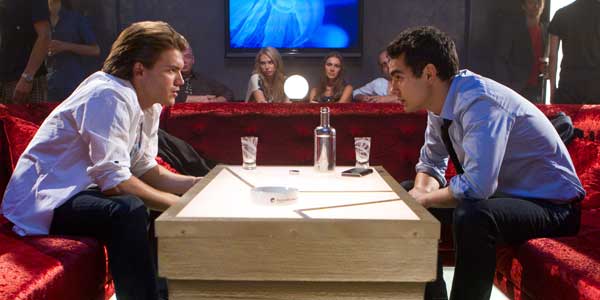
After two pairs of friends meet in a Moscow nightclub, their evening is interrupted by the swift arrival of invisible entities who waste no time in massacring everyone in sight. Hiding for as long as they can, the friend eventually venture out in search of anyone else who may have survived.
Thanks largely to the influence of Timur Bekmambetov (Night Watch), Moscow is fast becoming an in-demand filmmaking location. Its juxtaposition of lingering Cold War gloom and the new generation of neon vibrancy evokes a city of instant and fascinating contrast. Given the loving manner in which The Darkest Hour shoots the Russian capital, it’s unsurprising to learn that the demented Kazakh is one of The Darkest Hour’s producers.
The seemingly unstoppable nature of the aliens makes for more of a survival film rather than an action one, and also reduces the likelihood of any gung-ho heroics. How can you possibly hope to fight beings of pure energy that can disintegrate at will any matter they touch? The lack of an established character hierarchy, as well as the principal actors’ relative obscurity, mean that nobody is truly safe from the atomising lash of the unseen foes.
The electrical nature of the aliens is thought through well enough that you don’t stop to question the practical plausibility of such physiology. The static fields they generate cause lights to flicker when they are close, which, while helping to indentify their locations, also serves to mark their Inexorable progress towards anyone unlucky enough to be stranded in their path. Their invisibility, as well as cranking up the tension from the possibility of them being quite literally anywhere, harks back to old-school horror when the monstrous antagonists were largely unseen presences skulking in the shadows. When the big reveal occurs though really more like a series of glimpses their appearance is so utterly alien that you truly have little to visually compare them to. From a practical sense, the aliens being concealed for most of the film also craftily saves on CGI expenditure.
Full-on outer space invasion blockbusters have been light in recent years the distinctly average Cowboys & Aliens aside in favour of stories with more localised threats such as Attack the Block or Super 8. Although the Darkest Hour’s threat is soon learned to be global, established trends are still defied by the interlopers not being here to conquer, enslave, harvest or otherwise dominate humanity. As one character points out after an educated deduction regarding the aliens’ purpose is made: “We were just in the way.
Some neat touches add flavour to proceedings, like the silent wind blowing small clouds of ash that used to be people and a few attempts at wry humour such comparing the Cyrillic alphabet to Klingon.
As you would expect, the film focuses on tense encounters and frantic chases in place of any attempts at proper characterisation. The characters are sympathetic enough that you genuinely wish they make it out of danger, but neither are they drawn with enough dimensions to convince as rounded people.
Overall Verdict: The Darkest Hour is not really a film worthy of the spectacle of cinema the 3D adds vey little but more of a Friday night DVD rental with beer, pizza and friends. It’s engaging and intelligent enough for what it is, so view it on those terms and you’ll be fine.
Reviewer: Andrew Marshall